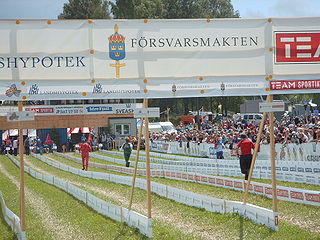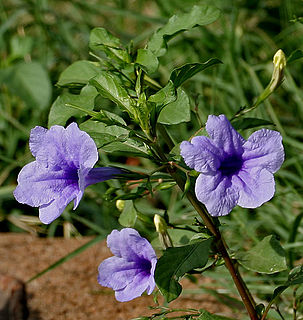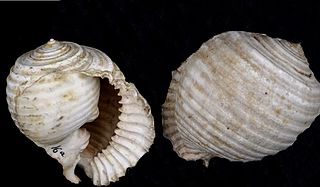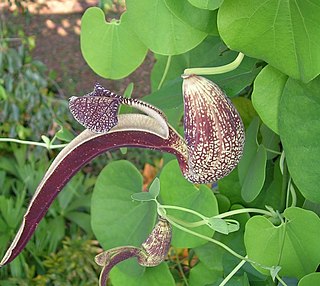
The Aizoaceae, or fig-marigold family, is a large family of dicotyledonous flowering plants containing 135 genera and about 1800 species. They are commonly known as ice plants or carpet weeds. They are often called vygies in South Africa and New Zealand. Highly succulent species that resemble stones are sometimes called mesembs.

The Peruvian anchoveta is a species of fish of the anchovy family, Engraulidae, from the Southeast Pacific Ocean. It has yielded greater catches than any other single wild fish species in the world, with annual harvests varying between 3.14 and 8.32 million tonnes throughout the 2010s.

Babiana ringens, the rat's tail, is a flowering plant endemic to Cape Province of South Africa. The foliage is long and erect with an inflorescence consisting of a sterile main stalk adapted for ornithophily, pollination by birds. The plant bears bright red, tubular flowers on side branches close to the ground. It is a perennial that grows in nutrient-poor sandy soil and flowers during the winter rains.

Babiana is a genus of geophytes in the family Iridaceae with 93 recognized species as of March 2022. The leaves consist of a stalk and a blade that are at an angle to each other. The leaf blades are entire, laterally flattened and pleated, and often hairy. Each individual flower is subtended by two hairy or smooth bracts that are green in most species. The outer bract is often the largest of the two. In most species the bracts have a dry, brown tip, but in a few species it is entirely green or entirely dry when flowering or the outer bract is translucent and has a papery texture. The inner bract is forked or split all the way to its base. Each flower is without a pedicel, with six tepals that are merged at their base into a tube and form a perianth that is mirror-symmetrical in most species, with three anthers implanted where the perianth tube widens and that are, in almost every species, clustered at one side of the style. The style has three branches that widen towards the tip and the ovary is inferior. Flowers occur in almost every conceivable colour, many have markings on some of the tepals, and few star-symmetrical flowers have a centre that strongly contrasts with the free part of the perianth. The majority of these species are endemic to the west and southwest of South Africa, and southwestern Namibia, but one species occurs elsewhere in Namibia and South Africa and another species can be found in Botswana, Namibia, South Africa, Zambia and Zimbabwe. The genus name is derived from the Dutch word baviaan, referring to the Chacma baboon, Papio ursinus, that consumes the corms of plants in the genus. The genus is called bobbejaantjie in Afrikaans, meaning small baboon.

The O-Ringen is an orienteering competition that takes place annually in different areas of Sweden. Orienteers from all over the world come to the competition. For orienteers around the world a trip to the O'ringen 5-days is their Mecca. This race attracts significant media coverage in Sweden and winning O-Ringen is often considered second only to the World Championships in prestige. The competition takes place in July, and takes place over 5 days, where every active day is a competition stage. Competitors are assigned start times for the first four stages of the race, but on the fifth and final stage a "chasing start" is used. In a chasing start the overall leader in each class starts first and the remaining competitors start according to the total time they trail. This means that the first runner over the finish line on the final stage is the winner.

Ruellia is a genus of flowering plants commonly known as ruellias or wild petunias. They are not closely related to petunias (Petunia) although both genera belong to the same euasterid clade. The genus was named in honor of Jean Ruelle (1474–1537), herbalist and physician to Francis I of France and translator of several works of Dioscorides.

The knifetooth dogfish, is a harmless sleeper shark of the family Somniosidae, found in the eastern Atlantic, from Scotland to Spain, Portugal, and Senegal, and the southwest Pacific from New Zealand, between latitudes 58°N and 15°N, at depths of between 200 and 1,600 m. Its length is up to 1.1 metres (3.6 ft).

Mimulus ringens is a species of monkeyflower known by the common names Allegheny monkeyflower and square-stemmed monkeyflower.

FDM Jyllands-Ringen is a motor racing circuit in Resenbro, near Silkeborg in Denmark. The circuit was extended from 1.475 km (0.917 mi) to 2.300 km (1.429 mi) in 2003, by linking the track to an adjacent oval circuit. Jyllands-Ringen hosted regular rounds of the Danish Touringcar Championship. From 2020, it also hosts races for TCR Denmark Touring Car Series.

Malea ringens, common name the grinning tun, is a species of large sea snail, a marine gastropod mollusk in the family Tonnidae, the tun shells.

Malea is a genus of large sea snails, marine gastropod mollusks in the family Tonnidae, the tun shells.

Elise Ringen is a Norwegian former biathlete.

Mimulus alatus, the sharpwing monkeyflower, is an herbaceous eudicot perennial that has no floral scent. It is native to North America and its blooming season is from June to September. The flowering plant has green foliage and blue to violet flowers. It has a short life span compared to most other plants and a rapid growth rate. Like other monkey-flowers of the genus Mimulus, M. alatus grows best in wet to moist conditions and has a bilabiate corolla, meaning it is two-lipped. The arrangement of the upper and lower lip petals suggests a monkey’s face. The winged stems together with the monkey face give the plant its common name.

Carruanthus ringens is from the Carruanthus genus of flowering plants from the ice plant family Aizoaceae. It has gained the Royal Horticultural Society's Award of Garden Merit.
Carruanthus peersii is from the Carruanthus genus of flowering plants from the ice plant family Aizoaceae.
Events from the year 1933 in Sweden

Aristolochia ringens is a species of perennial plant in the family Aristolochiaceae. It is found from Panama through Bolivia, Colombia, and Venezuela.
Robert Ringen Hermann, Sr. was an American businessman, soccer executive from St. Louis, Missouri.
Ruslan Glebov , also known as Ruslan Glibov, is a Ukrainian orienteering competitor. He was born in Dnipro, Ukraine.
Gemophos ringens, the ringed cantharus, is a species of sea snail in the family Pisaniidae.















